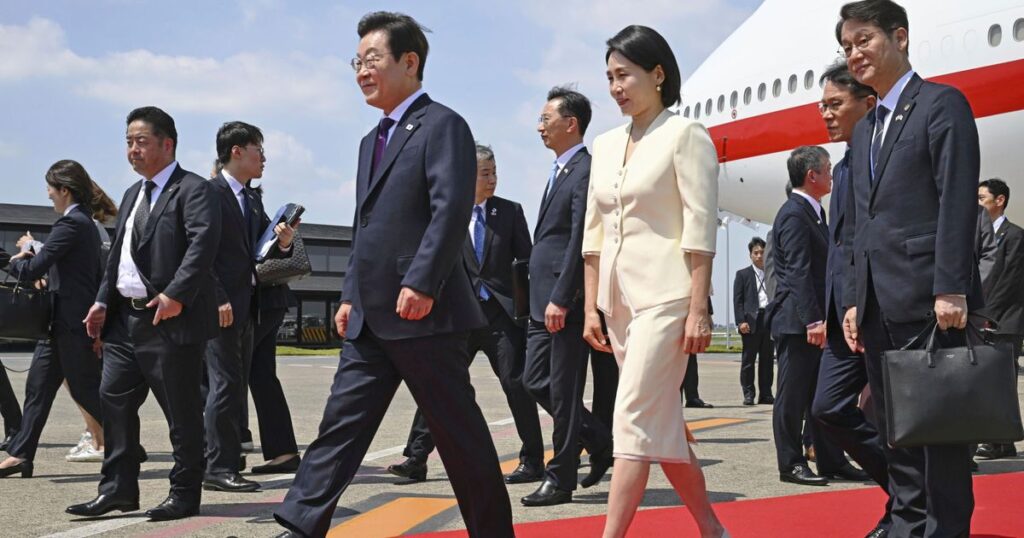SEOUL, South Korea — During the South Korean election campaign this year, Lee Jae Myung said he would crawl between President Donald Trump’s legs, if necessary, to protect his country’s national interests. But he also said, “I am not a pushover, either.”
Lee, who is now South Korea’s president, will put that balancing act to the test Monday when he and Trump meet for the first time in Washington.
The two leaders have a lot in common. Both survived assassination attempts before taking office. Both share an interest in meeting with North Korea’s leader, Kim Jong Un. But their priorities diverge when it comes to the 7-decade-old alliance between their two countries — especially over a potential conflict between China and Taiwan, which Beijing claims as its own.
Tens of thousands of U.S. troops have long been stationed in South Korea to deter North Korea, which has nuclear arms. But the Trump administration is demanding that Seoul take greater responsibility for its own defense, as Washington expands the role of its troops based in South Korea to help contain China. South Korea fears that this “strategic flexibility,” as the United States calls it, could leave it more vulnerable to the North and increase the chances of the South getting sucked into a war over Taiwan.
Seoul and Washington should ensure that strategic flexibility “will not undermine South Korea’s security” and the allies’ combined abilities to deter North Korea, Lee’s national security adviser, Wi Sung-lac, told reporters Friday.
The allies have found some common ground over that principle, Wi said. But officials were also wary of Trump’s unpredictability.
“If the president somehow feels that he needs to elicit some more public statements from Lee Jae Myung as a partner in countering the Chinese economic and military threat, that might put President Lee in a position that would take him beyond his current talking points,” Sydney Seiler, a Korea expert at the Center for Strategic and International Studies, said during an online panel discussion last week.
Officials in Seoul are also concerned that if China invades Taiwan and the United States uses its forces in South Korea to defend Taiwan, China and North Korea could open another military conflict on the Korean Peninsula.
Similar concerns were behind a 2006 joint statement in which the United States agreed to respect South Korea’s position that “it shall not be involved in a regional conflict in Northeast Asia against the will of the Korean people.” Only then did South Korea agree to respect “the necessity for strategic flexibility” of the U.S. forces in South Korea.
But that was before the United States saw China as its biggest security threat and made defending Taiwan from Chinese aggression a priority. In recent weeks, some policy analysts in Washington have suggested that the U.S. military should drastically reduce its presence in South Korea because it cannot freely use its bases there to fight a war elsewhere.
If South Korea resists Washington’s demand on strategic flexibility, “the United States can simply relocate key components of its forces in South Korea to another region where it will face less constraint in sending them into a Taiwan contingency,” said Chun Yung-woo, a former South Korean presidential adviser for diplomacy and national security.
This month, Gen. Xavier Brunson, the top U.S. military commander in Korea, said it should not be considered a foregone conclusion that the United States would want South Korea to join in a conflict between Taiwan and China.
But “what’s being asked of Korea is to be stronger” against North Korea so that the U.S. military might be able to “do other things,” Brunson told reporters at the U.S. base in Pyeongtaek.
On his way to the United States, Lee made a stopover in Tokyo and met with Prime Minister Shigeru Ishiba. In a nod to Washington, Lee and Ishiba agreed to improve bilateral ties so that their nations could cooperate better with the United States to help contain China and North Korea. They also compared notes on an overlapping set of challenges, including Trump’s high tariffs and his pressure on U.S. allies to increase their military spending.
Seoul and Washington have yet to hash out the details of the broad-stroke trade deal they agreed to last month. Trump agreed to lower his tariffs on South Korea’s exports, like Samsung phones and Hyundai cars, to 15% in return for a $350 billion investment package from the country. He has also said that South Korea should increase its annual contribution to the upkeep of the U.S. troops on its soil to $10 billion, more than nine times the current level.
These demands have some South Koreans wondering if it would be better to try to defend their country without U.S. troops. In recent years, surveys have shown that a majority of citizens want South Korea to build its own nuclear weapons instead of relying on the United States for protection.

